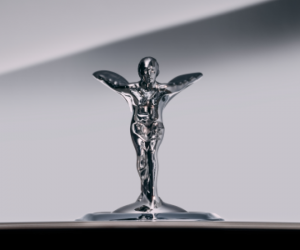Rolls-Royce Redesigns The Spirit Of Ecstasy In Preparation For An Electric Years Ahead - 3 minutes read

Image: Rolls-Royce
Rolls-Royce has redesigned its legendary Spirit of Ecstasy mascot for the Spectre, the company’s first all-electric vehicle. The move demonstrates the company’s commitment to the future and its goal of becoming entirely electric by 2030. On February 6, 1911, the graceful, iconic Spirit of Ecstacy officially became Rolls-intellectual Royce’s property. The Spirit of Ecstasy has undergone several design changes over the years, but it is still one of the most recognizable symbols in the world.
The Spirit of Ecstasy was modernized into a silky form that evokes movement by Rolls-Royce in 2020, thanks to a rebranding by Pentagram. The figurine is now more streamlined and elegant than it has ever been. The Spirit of Ecstasy, according to Torsten Müller-Ötvös, chief executive officer of Rolls-Royce, is “a constant source of inspiration and pride for the marque and its clients” and, like Rolls-Royce, “has always moved with the times while staying true to her nature and character.”
Rolls-designers Royce’s consulted Goodwood stylists on every imaginable aspect of the figurine’s new form, from “hair” and “clothing” to “expression.” According to design director Anders Warming, the Spirit of Ecstasy is “lower and more focused; braced for unprecedented speed and the exciting future” in the new design. Originally, the figurine stood with her feet together, straight legs, and a waist tilt.
The refined mascot now leans forward with one foot forward, expressing the brand’s never-ending pursuit of progress. Her dress flutters in the breeze around her, evoking images of Rolls-Royce products in motion, and her body is tucked low with eager eyes looking ahead.


Image: Rolls-Royce
The current design harkens back to its origins, closely resembling Charles Sykes’ original sketches. Sykes was the chief illustrator for The Car Illustrated, Britain’s first motoring magazine, founded by journalist and motoring enthusiast John Montagu. Eleanor Thornton, the magazine’s Office Manager and the character of a love affair with Montagu, was confirmed to be the inspiration for the beautifully crafted mascot.
In 1910, Claude Johnson, then the managing director of Rolls-Royce, tasked Sykes with creating a mascot to promote the company’s automobiles. Johnson, who was a key figure in the founding of Rolls-Royce and referred to himself as the “hyphen” in the company’s name, instructed Sykes to create an adornment inspired by the Louvre Palace’s marble sculpture “Nike of Samothrace.”
Sykes thought the Goddess of Victory Nike was too domineering during the design process and that a more delicate figure could better represent “the marque’s grace, silence, and subtle power.” Eleanor Thornton, who was highly intelligent, well-known for her beauty, and frequently posed for Sykes, was an inspiration. Sykes was also said to have created the Spirit of Ecstasy with his mother in mind, resulting in his artistic vision of “womanhood’s ideal.”
Every figurine was hand-cast, inscribed, and finished by Sykes himself back then. Before the outbreak of World War II in 1939, Sykes’ daughter took over the company in 1928. As a result, each figurine produced during that time is slightly different from the next. The figurines are now made by experts in Southampton using a wax casting process, combining ancient methods and materials with 21st-century technology. Each figurine will differ minimally from the others, in keeping with the marque’s tradition of the human element.

Image: Rolls-Royce
All future models will feature the Spirit of Ecstasy. Meanwhile, the Phantom, Ghost, Wraith, Dawn, and Cullinan will retain their previous design.